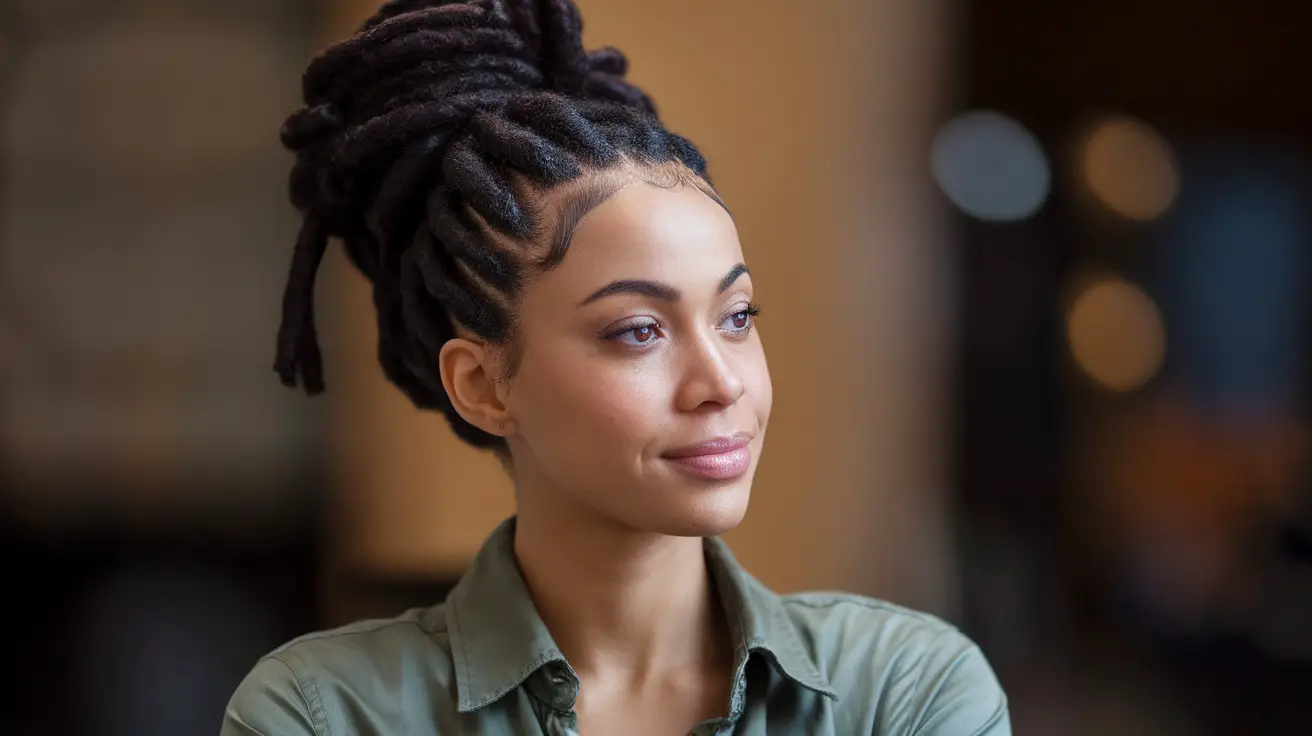Starter LOC styles are the initial techniques used to begin the process of creating dreadlocks. These styles lay the foundation for your hair’s journey into fully formed locs. From comb coils to two-strand twists, the variety of starter styles allows women to choose a method that suits their hair type and desired final look.
LOC styles offer a versatile and low-maintenance option for those seeking a natural hair journey. They provide a way to express individuality while celebrating the beauty of textured hair. These styles can be customized to fit various lifestyles and preferences, making them an attractive choice for women looking to simplify their hair care routine without sacrificing style.
In the following sections, we’ll explore the best starter LOC styles for different hair types and textures. We’ll discuss how to choose the right style for your hair, popular options this year, and tips for maintaining your new locs. Whether you have straight, wavy, curly, or coily hair, there’s a LOC style that can work for you. Keep reading to discover which starter LOC style might be your perfect match.
- What Are the Different Hair Types and Textures Suitable for LOC Styles?
- Which LOC Styles Work Best for Each Hair Type?
- How Do You Choose the Right Starter LOC Style?
- What Are the Most Popular Starter LOC Styles This Year?
- How Do You Maintain Your Starter LOC Style?
- Embracing Your Loc Journey: A Path to Self-Expression
- Frequently Asked Questions
What Are the Different Hair Types and Textures Suitable for LOC Styles?

LOC styles can be adapted to suit various hair types and textures, making them a versatile choice for many women. Let’s explore how different hair types can rock these styles.
Straight hair (Type 1)
You might think that straight hair isn’t suitable for LOC styles, but that’s not the case. While it may take longer to form locs, Type 1 hair can still achieve beautiful results. The key is patience and proper technique.
For straight hair, the process often begins with backcombing or twist and rip methods. These techniques create texture and help the hair to knot and form locs. It’s important to note that straight hair locs may be thinner and require more maintenance in the early stages.
Some tips for starting locs with straight hair:
- Use a sea salt spray to add texture
- Consider adding extensions for thickness
- Be patient, as the process may take longer
- Avoid over-washing in the early stages
- Use a residue-free shampoo to prevent buildup
Wavy hair (Type 2)
Wavy hair falls between straight and curly, offering a good foundation for LOC styles. This hair type often forms locs more easily than straight hair but may require some extra care to maintain definition.
Two-strand twists or braids are popular starting methods for wavy hair. These techniques help to define the loc pattern and encourage the hair to knot naturally. As your locs mature, you’ll notice they become more defined and easier to maintain.
Curly hair (Type 3)
Curly hair is well-suited for LOC styles, as its natural texture helps the locs form and hold their shape. This hair type often locs faster than straight or wavy hair, giving you quicker results.
For Type 3 hair, comb coils or two-strand twists are excellent starting methods. These techniques work with your natural curl pattern to create well-defined locs. You might find that your locs form more quickly and require less maintenance than other hair types.
Coily hair (Type 4)
Coily hair, also known as kinky hair, is perhaps the most natural fit for LOC styles. Its tight curl pattern allows for easy loc formation and maintenance. This hair type often locs the fastest and produces the most defined results.
Popular starting methods for Type 4 hair include comb coils, two-strand twists, and palm rolling. These techniques work with your natural texture to create beautiful, well-formed locs. You may notice your locs forming and maturing faster than other hair types.
Mixed hair textures
Many women have hair that doesn’t fit neatly into one category. If you have mixed textures, don’t worry! LOC styles can still work for you. The key is to choose a starting method that suits the majority of your hair texture.
For mixed textures, it’s often helpful to consult with a professional loctician. They can assess your hair and recommend the best starting method for your unique texture combination. This personalized approach can help you achieve the best results for your LOC journey.
Remember, regardless of your hair type, proper care and maintenance are crucial for healthy, beautiful locs. Regular cleansing, moisturizing, and retwisting will help your locs thrive, no matter your hair texture.
Which LOC Styles Work Best for Each Hair Type?

Choosing the right LOC style for your hair type can make a significant difference in your loc journey. Let’s explore some of the best starter styles for different hair textures.
Comb coils for Type 4 hair
Type 4 hair, with its tight coils and kinks, is perfectly suited for comb coils. This method involves using a fine-toothed comb to create small, spiral-shaped sections of hair. The natural texture of Type 4 hair helps these coils hold their shape and eventually form into locs.
Why are comb coils so effective for Type 4 hair? The answer lies in the hair’s structure. The tight curl pattern allows the coils to stay in place without much effort, making the loc formation process smoother and faster.
To create comb coils:
- Start with freshly washed and conditioned hair
- Section your hair into small, manageable parts
- Use a rat-tail comb to twist each section from root to tip
- Apply a loc-friendly gel or cream for hold
- Allow the coils to air dry completely
Two-strand twists for Type 3 and 4 hair
Two-strand twists work well for both Type 3 and Type 4 hair. This versatile method creates a strong foundation for locs while allowing for a bit more flexibility in styling during the early stages.
For Type 3 hair, two-strand twists can help define the loc pattern and encourage the hair to knot naturally. Type 4 hair benefits from this method as well, with the twists helping to control frizz and maintain a neat appearance during the loc formation process.
Braids for Type 1 and 2 hair
If you have Type 1 (straight) or Type 2 (wavy) hair, braids can be an excellent starting point for your loc journey. Braiding helps to add texture and grip to hair types that might otherwise struggle to form locs on their own.
The braid method works by creating a pattern that encourages the hair to tangle and knot as it grows. Over time, these braids will begin to form into locs. It’s important to note that this process may take longer for straight and wavy hair types, so patience is key.
Interlocking for all hair types
Interlocking is a versatile technique that can work for all hair types, from straight to coily. This method involves using a tool to pull the end of the loc through the root, creating a tight, neat appearance.
One of the main advantages of interlocking is its ability to maintain a polished look, even during the early stages of loc formation. This can be particularly beneficial for those with straight or wavy hair, as it helps to keep the locs in place and prevent unraveling.
How often should you interlock? The frequency depends on your hair type and growth rate. Generally, every 4-6 weeks is a good starting point, but you may need to adjust based on your individual needs.
Palm rolling for Type 3 and 4 hair
Palm rolling is a simple yet effective technique for maintaining and tightening locs, particularly for Type 3 and 4 hair. This method involves rolling the loc between your palms to encourage the hair to knot and tighten.
For those with curly or coily hair, palm rolling can help to:
- Maintain the shape of your locs
- Reduce frizz and flyaways
- Promote even loc growth
- Keep your locs neat and tidy
To palm roll effectively, start at the root of each loc and roll it between your palms, moving down to the tip. You can use a small amount of loc-friendly product for added hold and moisture.
Selecting the right starter LOC style for your hair type can set you up for success on your loc journey. Whether you opt for comb coils, two-strand twists, braids, interlocking, or palm rolling, each method has its strengths. Consider your hair texture, desired final look, and maintenance preferences when making your choice. With the right technique and a bit of patience, you’ll be on your way to beautiful, healthy locs.
How Do You Choose the Right Starter LOC Style?

Selecting the right starter LOC style is a crucial step in your loc journey. This decision can impact how your locs form, grow, and look in the long run. Let’s explore the key factors to consider when making this choice.
Consider your hair texture
Your hair’s natural texture plays a significant role in determining the best starter LOC style for you. Different textures respond differently to various loc formation methods.
For instance, if you have Type 4 hair with tight coils, you might find that comb coils or two-strand twists work exceptionally well. These methods complement your hair’s natural tendency to coil and lock.
On the other hand, if you have straighter hair (Type 1 or 2), you might need to consider methods that add more texture, such as braiding or backcombing. These techniques can help your hair form locs more easily.
Think about your desired final look
What’s your vision for your locs? Do you want them to be thin and numerous, or thick and chunky? Your desired end result should guide your choice of starter style.
If you’re aiming for thinner locs, you might opt for smaller sections when creating your starter locs. This could mean using smaller comb coils or thinner two-strand twists.
For thicker locs, you’d start with larger sections. Chunky twists or braids could be a good option in this case.
Remember, the size of your starter locs will influence the final size of your mature locs. So, take some time to visualize your ideal loc look before you begin.
Factor in your lifestyle and maintenance preferences
Your daily routine and how much time you can dedicate to loc maintenance are important considerations. Some starter styles require more frequent maintenance than others.
For example, if you lead a busy lifestyle and prefer low-maintenance hair, interlocking might be a good choice. This method typically requires less frequent retightening compared to other styles.
On the flip side, if you enjoy spending time on your hair and don’t mind more frequent maintenance, two-strand twists or comb coils could work well for you. These styles often need more regular retwisting, especially in the early stages of loc formation.
Consider these lifestyle factors when choosing your starter style:
- How much time can you dedicate to hair care?
- Are you comfortable with frequent salon visits?
- Do you prefer a more hands-off approach to hair maintenance?
- How active is your lifestyle? (Some styles hold up better during physical activities)
Consult with a professional loctician
While it’s great to do your own research, nothing beats the personalized advice of a professional loctician. These experts can assess your hair in person and provide tailored recommendations based on your hair type, desired look, and lifestyle.
A professional can also spot any potential challenges your hair might face during the loc journey. They can suggest strategies to overcome these challenges and set you up for success.
During your consultation, don’t hesitate to ask questions. A good loctician will be happy to explain the pros and cons of different starter styles for your specific hair type.
Assess your hair’s length and thickness
The length and thickness of your hair can influence which starter styles are feasible for you. Some methods work better with longer hair, while others are suitable for shorter lengths.
If you have short hair, you might find that comb coils or interlocking work well. These methods can be effective even with just a few inches of hair growth.
For those with longer hair, you have more options. Two-strand twists, braids, and palm rolling can all be effective starter methods for longer hair.
Hair thickness also matters. If you have fine hair, you might want to start with smaller sections to ensure your locs aren’t too thin. Conversely, those with thick hair might opt for larger sections to prevent their locs from becoming too bulky.
Choosing the right starter LOC style is a personal decision that depends on various factors. By considering your hair texture, desired look, lifestyle, and seeking professional advice, you can make an informed choice. This thoughtful approach will set you on the path to achieving the beautiful, healthy locs you desire.
What Are the Most Popular Starter LOC Styles This Year?

Starter LOC styles have evolved over the years, with new trends emerging and classic methods gaining fresh popularity. This year, we’re seeing a mix of innovative techniques and timeless favorites. Let’s explore the most sought-after starter LOC styles that are making waves in the hair community.
Micro locs for fine hair
Women with fine hair often struggle to find a LOC style that works well for their hair texture. Enter micro locs – a game-changing option that’s gaining traction this year. These ultra-thin locs are perfect for those with fine or thin hair, as they create the illusion of fullness and volume.
How small are micro locs? Typically, they range from 1/8 to 1/4 inch in diameter. This small size allows for incredible versatility in styling, from intricate updos to flowing, loose looks.
Creating micro locs requires patience and precision. The process often involves using a fine-toothed comb or small crochet hook to form tiny, uniform sections. While the initial installation can be time-consuming, many women find the results well worth the effort.
Sisterlocks for versatility
Sisterlocks have been around for a while, but they’re experiencing a resurgence in popularity this year. This patented technique creates very thin, uniform locs that offer unparalleled styling versatility.
What sets Sisterlocks apart? Here are some key features:
- Extremely thin locs (often thinner than micro locs)
- Uniform size and shape
- Ability to style in various ways, including curls and updos
- Low maintenance once established
- Suitable for most hair types and textures
One thing to note: Sisterlocks require installation by a certified consultant. While this might seem inconvenient, it helps to maintain the quality and consistency of the technique.
Traditional locs for a classic look
Sometimes, the classics never go out of style. Traditional locs remain a popular choice for many women starting their LOC journey. These locs are typically thicker than micro locs or Sisterlocks, ranging from 1/2 to 1 inch in diameter.
Traditional locs offer a bold, statement-making look that many women love. They can be started using various methods, including palm rolling, twisting, or backcombing. The choice of method often depends on your hair texture and personal preference.
One advantage of traditional locs is their relatively low maintenance. Once established, they require less frequent retightening compared to some other styles. This makes them an excellent option for women who prefer a more hands-off approach to hair care.
Freeform locs for a natural approach
For those who prefer a more organic look, freeform locs are gaining popularity this year. This method involves allowing your hair to loc naturally, with minimal manipulation.
The freeform approach can result in locs of varying sizes and shapes, creating a unique, one-of-a-kind look. Many women appreciate the freedom and self-expression that comes with this style.
How do you start freeform locs? It’s simpler than you might think. Essentially, you wash your hair regularly and allow it to tangle and knot naturally. Some people choose to separate their hair into large sections to guide the loc formation, while others let their hair loc completely on its own.
Butterfly locs for a bohemian vibe
Butterfly locs are a relatively new style that’s quickly gaining popularity. These locs have a distinctive look, characterized by a slightly messy, unraveled appearance that resembles butterfly wings.
Creating butterfly locs involves using the crochet method with wavy hair extensions. The result is a soft, bohemian look that many women find appealing. The style offers a nice balance between structure and free-flowing texture.
One of the advantages of butterfly locs is their temporary nature. They typically last for 4-6 weeks, making them a great option if you want to try out the loc look without a long-term commitment.
Choosing a starter LOC style is a personal decision that depends on various factors, including your hair texture, desired look, and maintenance preferences. Whether you opt for micro locs, Sisterlocks, traditional locs, freeform locs, or butterfly locs, each style offers its own benefits and aesthetic appeal. The key is to select a style that aligns with your personal taste and lifestyle.
How Do You Maintain Your Starter LOC Style?
Maintaining your starter LOC style is crucial for healthy, beautiful locs. Let’s explore some essential care techniques to keep your new locs looking their best.
Proper washing techniques
Washing your starter locs requires a gentle touch. You might be tempted to scrub vigorously, but this can cause frizz and unraveling. Instead, focus on cleansing your scalp and allowing the suds to run down the length of your locs.
How often should you wash? This depends on your hair type and lifestyle. Generally, washing every 1-2 weeks is sufficient. Use a residue-free shampoo to avoid buildup that can weigh down your locs.
Here’s a simple washing routine:
- Wet your hair thoroughly
- Apply shampoo to your scalp and gently massage
- Let the suds run down your locs as you rinse
- Squeeze excess water out gently – don’t rub with a towel
Moisturizing and hydrating tips
Keeping your locs moisturized is key to preventing breakage and promoting healthy growth. But be careful not to over-moisturize, as this can lead to mildew and other issues.
A good rule of thumb is to moisturize your locs 2-3 times a week. Use light, water-based products that won’t leave residue. Avoid heavy oils and butters, especially in the early stages of loc formation.
Try this moisturizing technique: Mix a small amount of leave-in conditioner with water in a spray bottle. Spritz this mixture onto your locs, focusing on the ends. Gently pat the moisture in, don’t rub.
Retwisting and maintenance schedule
Regular retwisting helps your locs maintain their shape and promotes neat growth. However, over-twisting can cause thinning and breakage, so it’s important to find the right balance.
For most people, retwisting every 4-6 weeks is sufficient. If you have very coarse or kinky hair, you might be able to go longer between retwisting sessions.
When retwisting, use a light hold gel or loc cream. Avoid products with alcohol, as these can dry out your hair. Start at the roots and twist in the direction your locs naturally grow.
Protecting your locs while sleeping
Nighttime care is often overlooked, but it’s crucial for maintaining your starter locs. Friction from your pillow can cause frizz and loosen your locs.
Invest in a satin or silk pillowcase. These smooth fabrics reduce friction and help retain moisture in your hair. Alternatively, you can wrap your hair in a satin scarf or bonnet before bed.
If your locs are long enough, try pineappling. This involves gathering your locs loosely at the top of your head. Secure them with a soft scrunchie or hair tie, being careful not to pull too tight.
Avoiding common mistakes in loc care
Even with the best intentions, it’s easy to make mistakes when caring for your starter locs. Being aware of these common pitfalls can help you avoid them.
One frequent error is using the wrong products. Stick to products specifically designed for locs or natural hair. Regular conditioners and styling products can leave residue that’s difficult to remove from locs.
Another mistake is neglecting your scalp. A healthy scalp is the foundation for healthy locs. Gently massage your scalp regularly to stimulate blood flow and promote growth.
Patience is key with locs. Don’t expect perfect, mature locs overnight. The loc journey takes time, and each stage has its own beauty. Resist the urge to constantly style or manipulate your locs, especially in the early stages.
Lastly, don’t skip professional help. While you can maintain your locs at home, regular visits to a loctician can help catch and correct any issues early on.
By following these maintenance tips, you’ll set yourself up for a successful loc journey. Remember, every head of locs is different, so don’t be afraid to adjust your routine as you learn what works best for your hair. With proper care and patience, your starter locs will grow into beautiful, mature locs that you’ll love for years to come.
Embracing Your Loc Journey: A Path to Self-Expression
Starting your loc journey is an exciting adventure that allows you to express your individuality and celebrate your natural hair. From choosing the right starter style to mastering maintenance techniques, each step of the process contributes to the unique beauty of your locs. Whether you opt for micro locs, Sisterlocks, traditional locs, or any other style, remember that patience and consistent care are key to achieving the look you desire.
As you embark on this hair transformation, keep in mind that your loc journey is personal and unique. What works for one person may not work for another, so don’t be afraid to experiment and find the techniques that suit your hair best. With proper care, your starter locs will evolve into a stunning, low-maintenance hairstyle that reflects your personality and style. Enjoy the process, embrace the changes, and look forward to the beautiful, mature locs that await you at the end of your journey.
Frequently Asked Questions
Q: What are starter LOC styles?
A: Starter LOC styles are initial techniques used to begin the process of creating dreadlocks, such as comb coils, two-strand twists, and braids.
Q: Can people with straight hair get locs?
A: Yes, people with straight hair can get locs, but it may take longer and require different techniques compared to those with curly or coily hair.
Q: How often should I wash my starter locs?
A: Generally, washing starter locs every 1-2 weeks is sufficient, depending on your hair type and lifestyle.
Q: What’s the best way to moisturize starter locs?
A: Use light, water-based products 2-3 times a week, focusing on the ends of your locs. Avoid heavy oils and butters.
Q: How often should I retwist my starter locs?
A: For most people, retwisting every 4-6 weeks is sufficient. Those with very coarse or kinky hair might be able to go longer between sessions.
Q: What are micro locs?
A: Micro locs are ultra-thin locs, typically 1/8 to 1/4 inch in diameter, that are particularly suitable for those with fine or thin hair.
Q: How can I protect my starter locs while sleeping?
A: Use a satin or silk pillowcase, or wrap your hair in a satin scarf or bonnet before bed to reduce friction and retain moisture.
Q: What’s the difference between Sisterlocks and traditional locs?
A: Sisterlocks are very thin, uniform locs created using a patented technique, while traditional locs are typically thicker and can be started using various methods.
Q: Are freeform locs high-maintenance?
A: Freeform locs are generally low-maintenance, as they involve allowing your hair to loc naturally with minimal manipulation.

